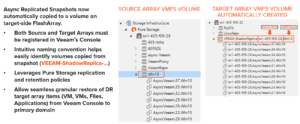Datacenter outages, from accidental database deletion to something more nefarious like a ransomware attack, is an unfortunate inevitability in today’s world. IT organizations are judged upon missed SLAs and downtime under more scrutiny than ever before, adding pressure. Having been witness to this new paradigm for a while now, something we have observed is that the businesses you don’t read about – who don’t have major outages or data breaches – have data protection approaches in two key areas. First: they define, practice, and iterate their internal data recovery process continuously. The other component is they have modernized their data protection strategy with best of breed hardware and software. When the real thing happens, they are prepared with a blueprint and infrastructure proven to minimize RPOs and RTOs. In this post, we are going to focus on our partnership with Veeam and show existing and new methods for data protection for your primary FlashArray(s).
Below is a summary of the functionality Veeam and Pure Storage have been offering for VMFS volumes since our integration was first introduced over a year ago:
- Leverage array-based snapshots for backup jobs

- Restore a single VM or group of VMs from a VMFS volume
- Restore individual files within a guest OS
- Veeam Explorer can restore Microsoft applications, SQL, and Oracle workloads with a high degree of specificity (e.g. restore a single important email that your CEO deleted)
What started off as an already feature-rich integration has been improved upon further to make recovery and test/dev even easier amongst your FlashArray™ fleet. While Pure has very robust snapshot and replication technologies that are a core component of our product, an array-based volume snapshot alone is not a data protection strategy. What I mean by this is that for true data resiliency, that backup needs to be stored someplace else … be it on a FlashBlade™ or replicated to a secondary Pure Storage array with ActiveCluster™ or with asynchronous replication.
The enhancement that we want to highlight today is FlashArray snapshots on the target side of an asynchronous replication group will now be automatically copied to a volume. This is important for customers managing many volumes at scale since automating the step of copying a snapshot to a volume will save time during an outage. This slide shows what it looks like within the Veeam console with some more details:

This enhancement also represents increased utility for test/dev instances using Veeam DataLabs. Now, you can have the most recent VMFS volume snapshots available on your DR array and make them available as test/dev instances for your DBAs, patch and virus testing before production rollout, the list goes on and on. Putting backup data to work in this fashion helps maximize the ROI of this underutilized equipment and allows you to be much more proactive. Worth mentioning is that this new enhancement is tunable, so customers not wanting to use this new feature can turn it off if desired.
A free Veeam account is all that is necessary to upgrade to this latest revision of the plugin. Best of all, this is available at no additional cost to our joint customers.






